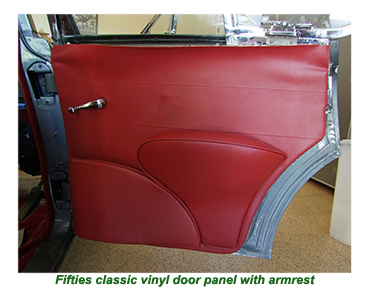 The process of overseeing a complete classic car restoration takes in a multitude of intricate aspects that encompass the various skills that humans have honed over the past century or more. The process involves numerous moving parts, including the management of chemical chain reactions and addressing various associated challenges.
The process of overseeing a complete classic car restoration takes in a multitude of intricate aspects that encompass the various skills that humans have honed over the past century or more. The process involves numerous moving parts, including the management of chemical chain reactions and addressing various associated challenges.
 Given the high level of pressure involved, it is understandable that a car restorer may not prioritise seemingly trivial components like door panels and armrests. However, it is important to note that disregarding these items would be an error in judgement.
Given the high level of pressure involved, it is understandable that a car restorer may not prioritise seemingly trivial components like door panels and armrests. However, it is important to note that disregarding these items would be an error in judgement.
 They play a crucial role in the restoration project, just like a meticulously fine-tuned twelve-cylinder engine.
They play a crucial role in the restoration project, just like a meticulously fine-tuned twelve-cylinder engine.
Early-model armrests typically featured a basic sheet-metal base that was covered in fabric. To enhance comfort, a thick rubber pad was often placed on top of the steel structure. The armrest is typically installed on the interior side of the door, positioned above the top panel, and secured using screws.
As armrests have undergone advancements, the bases have been constructed using injection-molded contoured plastic. These bases are typically equipped with a vinyl-covered moulded rubber pad that is securely fastened on top.
By the late Fifties, automotive styling had advanced significantly, with certain car manufacturers integrating armrests directly into the door panels. This innovative design approach, which emerged during that era, continues to be utilised in modern vehicles.
 When assessing a vintage automobile prior to restoration, it is common to observe varying degrees of wear on the armrests.
When assessing a vintage automobile prior to restoration, it is common to observe varying degrees of wear on the armrests.
 When renewing armrests and door panels, it is important to note that not all doors necessarily receive the same treatment. This is done to ensure continuity throughout the vehicle's interior.
In the early days, many classic vehicles were equipped with door panels crafted using durable materials such as concentrated cardboard or plastic. These panels were then carefully upholstered with high-quality fabric, vinyl, or leather to complement the car's interior aesthetics.
When renewing armrests and door panels, it is important to note that not all doors necessarily receive the same treatment. This is done to ensure continuity throughout the vehicle's interior.
In the early days, many classic vehicles were equipped with door panels crafted using durable materials such as concentrated cardboard or plastic. These panels were then carefully upholstered with high-quality fabric, vinyl, or leather to complement the car's interior aesthetics.
One potential drawback of this approach arises when a panel becomes damaged or goes missing. In such instances, recreating the panel manually can prove to be an extremely challenging task.
In the event that maintaining strict authenticity is not the number one priority, the restorer can explore numerous online options that offer a wide range of choices. These options should be able to provide an upholstery solution that closely resembles or even starkly contrasts with their current upholstery.
 Many companies that specialise in marketing "door furniture" for cars online typically provide comprehensive turnkey packages. These packages often include a range of components such as kick panels, dashboard covers, door panels, armrests, instrument panel covers, and door panel inserts.
Many companies that specialise in marketing "door furniture" for cars online typically provide comprehensive turnkey packages. These packages often include a range of components such as kick panels, dashboard covers, door panels, armrests, instrument panel covers, and door panel inserts.
All of the products are carefully designed to ensure colour coordination and straightforward installation.
In contrast, when undertaking a restoration project involving a luxury vehicle, it is crucial to ensure that the door handles and armrests upholstery are accurately matched. These components can be made of either hide or velour trim. In such cases, many restorers prefer to entrust the task to a specialist car upholsterer who possesses the necessary expertise to deliver exceptional results, albeit at a higher cost.
 If the individual possesses the requisite skills, as well as the time and inclination to undertake the task, they can save money by taking on the job of restoring or repairing their existing door panels, although to achieve desirable results they will require a combination of specialised expertise and access to the necessary equipment.
If the individual possesses the requisite skills, as well as the time and inclination to undertake the task, they can save money by taking on the job of restoring or repairing their existing door panels, although to achieve desirable results they will require a combination of specialised expertise and access to the necessary equipment.
Take me back to the home page.
Take me back to the home page.
cu2

